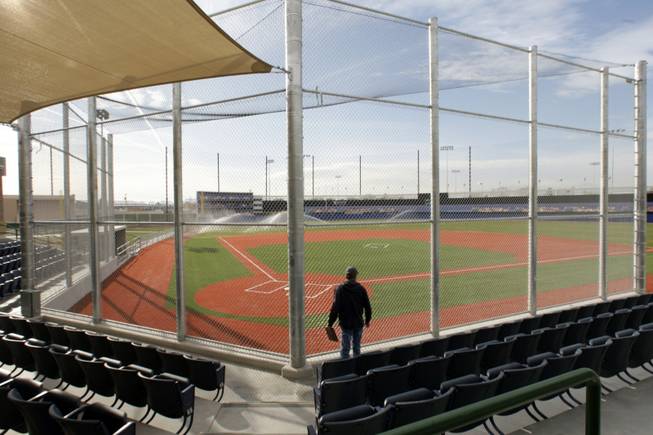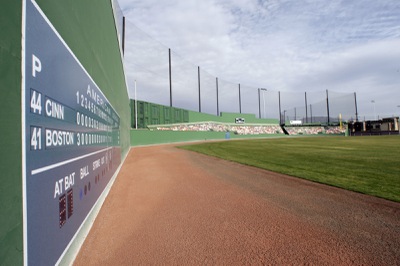
An inspector looks over the Big League Dreams complex at Freedom Park on Dec. 21. The complex, scheduled to open Jan. 16, is being built by Las Vegas, but operated and maintained by Big League Dreams, a private company.
Friday, Jan. 8, 2010 | 3 a.m.
Big league dreams have come true in Las Vegas for one California company.
Las Vegas will open its $28.5 million Big League Dreams softball and baseball complex Jan. 16 at the renovated Freedom Park as part of a joint venture with California-based Big League Dreams.
The company will maintain and operate the sports complex at no cost to the city and share proceeds from its two restaurants and operations.
Las Vegas marks the 10th complex the company has opened since 1997 when it first partnered with Cathedral City near Palm Springs.
The company designs the complexes to mimic major league parks scaled to smaller dimensions.
It borrows from such major league stadiums as Wrigley Field in Chicago, Fenway Park in Boston and Yankee Stadium in New York. Those are among the designs used in the six ballparks at Freedom Park. The others are Angel Stadium in Anaheim, Calif.; Dodger Stadium in Los Angeles; and the former Polo Grounds in New York City.
The company run by brothers Jeff and Rick Odekirk started by accident. Jeff, who is the managing director and chief operating officer, said the two wanted a sports business and focused on baseball camps at first.
Ex-major league managers and current players were guest instructors for youth leagues. The response was so huge that the fledgling company needed fields large enough to hold the camps.
Their business plan called for building a facility with five fields where everybody could come to one location in Palm Springs. But they soon learned running baseball camps wasn’t that great of a business and the brothers soon saw the potential of privatizing softball leagues, holding youth leagues and ultimately hosting tournaments.
“We wanted to run youth baseball camps and then run adult softball at night during the week, but it turned out the camp business was not one that could sustain itself for what we were doing with the complex,” Odekirk said. “But there was a very active softball tournament market, and fortunately, the tournament industry for youth baseball and girls fast-pitch softball exploded. We became a destination for youth travel teams.”
Since then, it has opened parks in the California cities of Mira Loma, Chino Hills, Redding, Manteca and West Covina. It has two in Texas, one in Arizona, and it has three more planned in California. New Orleans has hired the firm to do a feasibility study.
The company had been eyeing Southern Nevada since its inception, Odekirk said. It flirted with Henderson when it was considering a spring-training complex.
Las Vegas was a considered a prime location because it’s a destination that will attract teams from across the country.
The nine existing complexes attract 70 percent youth teams with the remaining 30 percent adult softball teams. In Las Vegas, that will probably flip to 70 percent adult softball and 30 percent youth because of the interest in adults in coming here, Odekirk said.
The region doesn’t have enough fields at one complex to hold a tournament of 50 or more teams, he said.
“We see a lot of teams travel long distances to play at Big League Dreams parks, but none of the locations is as exciting as Las Vegas,” Odekirk said. “It is unbelievable to us how many adult softball teams in Southern California have never played here, or it’s been a long time since they played here.”
Las Vegas officials are looking forward to the opening of the complex that will bring more visitors to the city for the weekend tournaments.
“They have had a lot of parks and all of them have been very successful,” said Pat Batte, a Las Vegas government project manager. “They have marked their products very well. Their tournaments are a destination. They draw teams from nationwide.”
The concept has grown as cities have had to deal with budget problems, Odekirk said. They may have the land and money to build a park, but not the hundreds of thousands of dollars it may cost a year to maintain it.
“That is where we come in,” Odekirk said. “They never have to put another penny in it. We will show them how to design the parks and be profitable. They own them, and we have a long-term maintenance and operating agreement of 30 years.”
The Big League Dreams parks cost about 25 percent to 30 percent more than a typical city park, but local governments make up for it over time by not spending anything on maintenance and sharing the income from the complex, Odekirk said.
That ranges from 6 percent to 10 percent over the life of the lease and the parks have annual gross income of $2 million to $4 million, he said. More than $11 million have been paid to local government partners since the company’s inception. Revenue comes in from the sports leagues and tournaments, which are held almost every weekend, and from restaurants at the complexes.
Las Vegas’ park, for example, will have two restaurants that serve as hubs for three-field complexes. Each restaurant has seating for 200 people who can watch a game while eating.
The complexes are also used for corporate parties and softball outings that generate revenue, Odekirk said.
The concept only works where the weather is good year round because a complex needs to keep generating revenue to pay for itself, he said.
“Florida seems like it will be the next frontier for us, and we will probably see some growth in Northern California, Phoenix and Texas,” Odekirk said. “There is a lot of room to grow, although we are limited to warm-weather states.”
The concept of replicating the baseball fields was the company’s signature because both kids and adults wanted the feel of what it was like to play in the big leagues with stadium-style seating even though there isn’t the second deck, Odekirk said.
They pored over photographs and visited stadiums and came up with scaled-down versions of the classic stadiums such as the white arches of Yankee Stadium. The Green Monster left-field wall at Fenway Park is scaled down from 37 feet to 24 feet and the brick facade at Wrigley Field is replaced with a wooden fence with ivy growing on it.
Big League Dreams is free to take from the major league designs before 1989, but needs to pay for the licensing for those built in the last two decades and has done so with the Arizona Diamondbacks’ Chase Field.



Join the Discussion:
Check this out for a full explanation of our conversion to the LiveFyre commenting system and instructions on how to sign up for an account.
Full comments policy